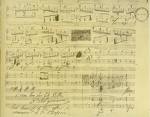F. Chopin: Sonata No. 3 – Nelson Freire

NELSON FREIRE: Chopin – Piano Sonata No.3 Études op.25
Recorded in 2002. Decca #02894702882
The context
This CD brings together two names both respected and well-known: Frederic Chopin, whose compositions for the piano – universally known and admired today – still sound fresh brilliant and moving 160 years after they were written; and Nelson Freire, outstanding Brazilian pianist – even in a country prodigal with such – today just turning 60, receiving just acclaim for the maturity of his exceptional talent. After not recording for many years, Nelson has now produced this CD of Chopin and another of Schumann. If you go to Modern Sound in Copacabana, the attendant in the Classical section has a special open box for Nelson’s Chopin CD – nothing easier!
The composer
Chopin was born in 1810 in Zelazowa Wola, Poland, but his family moved afterwards to Warsaw, where his father lectured in French language and literature. His musical talent soon came apparent – he had a Polonaise published when he was 7 – but he received formal piano instruction (from a violinist) only until he was 12. During his teens, summers were spent in the interior, where he became particularly interested in folk music and country traditions. From 16, he attended the Warsaw School of Music, where he studied the theory of music and composition, receiving a firm theoretical grounding. In this period, he wrote some of the compositions which would make his name, like the “La ci darem” variations op.2 on a theme of Mozart, as well as works for piano with orchestra.
In November 1830 he left Warsaw to travel in Europe, but in Vienna he heard of the Warsaw Uprising, against the domination of Poland by Russia. While his travelling companion returned to Poland to join the insurgent army Chopin stayed in Vienna, venting his worry and frustration in his music. From this time comes the inspiration for some of his most impassioned and heroic pieces.
In November 1831 Chopin arrived in Paris, which was then was full of pianists and expatriate Poles; he quickly became a distinguished figure in Society. However, he did not like performing in public. His main source of income was from giving lessons, while his music had publishers in France, England and Germany. (We should remember that this was the time when music-making was the main sort of entertainment in the home, and every well-brought-up girl was expected to play the piano to entertain the guests). He would play at salons, where he was much in demand.
Chopin chose to remain an emigré, and could not return to Poland. He met his parents outside Poland in 1835, and in 1836 became engaged to the daughter of family friends, Maria Wodsinski. He wrote the first two of the Études op 25 (on this CD) into her album. However, the engagement was conditional on Chopin looking after his health, and in mid-1837 it was broken off by Maria’s family. Later that year, he entered into a close liaison with the French novelist George Sand. She was his older by six years, a divorcee with two children, but she offered the lonely artist what he missed most since leaving Warsaw: tenderness, warmth and maternal care. When he became seriously ill with tuberculosis in Majorca in 1838, she nursed him back to health. From 1839, Chopin lived in the summer at her house at Nohant, in central France, returning to Paris only for winters. The subsequent years were the happiest and the most productive in his life, when he composed the majority of his most profound works. However, the relationship broke up in 1847. From then on, his life was of depression, illness and decline, and he composed scarcely anything more. A trip to England in 1848 did not restore his spirits, and although nursed by his sister and surrounded by friends, tuberculosis wreaked its final toll in October 1849. He was 39.
Chopin and the creative process
According to Liszt “The character of Chopin [had not].. a single impulse, which was not dictated by the nicest sense of honor, the most delicate appreciation of affection”. How come this courteous and refined gentleman expresses such romance, passion, tragedy, tenderness and heroism in his music? Perhaps we can discern in his life reasons for loneliness, yearning for his homeland, frustration at his unfulfilled love and ill-health. His submerged passions then were poured into his music, via an incredible sensitivity and unbridled creativity.
It seems that melodies and ideas would burst into his mind, and he would write down sketches in a form which only he could understand. Then he would work these into  finished pieces – but often connecting the fragments would give him immense trouble, and he would scratch out and alter time after time. His ideas would not be still even after preparation for publishing, and he would even make alterations on publisher’s proofs – sometimes different alterations for different publishers!
finished pieces – but often connecting the fragments would give him immense trouble, and he would scratch out and alter time after time. His ideas would not be still even after preparation for publishing, and he would even make alterations on publisher’s proofs – sometimes different alterations for different publishers!
Sonata No. 3
Chopin’s music has lovely melodic lines, often written over a flowing, gentle bass part. It is never dull, because the harmonies change in unexpected and appealing ways – nor is it incomprehensible, because the melodies return, are reworked with more ornaments or with greater strength, giving a structure to the piece that can be followed. But we also find strong chords, and explosions of passion, when the notes cascade up and down, and the octaves boom out, as if the piano were not sufficiently large to contain such emotion. There are too delicate fairy traces, and subtle shifts of harmony which suddenly transform the sentiment of a passage. This music appeals both to feminine sensibility and male heroism: it is lyrical, romantic, but never effeminate.
This is true of Sonata No. 3, written in 1844 in Chopin’s maturity. The first movement, although marked Allegro maestoso for the opening forthright chords, soon rushes ahead, threatens storms – and then dissolves into a summer breeze of a melody, which itself dissolves into shimmering patterns like the wind in the trees… but then strong chords pull us back for a repeat with variations, which meander on like an enormous musical doodle, where the pen lightly sketches an image before wandering off again.
The Scherzo is ever so light, cascading up and down the piano, but has a homely middle part to tie it to reality. Largo has a lovely melody above a gently rocking left hand, which modulates delicately to arrive at a rippling interlude – oh so peaceful – before coming to a series of subtle and unusual changes in harmony, which gradually work their way back to the melody. But this return is brief, and soon quiet chords fade away into silence.
Finale: Presto non tanto has a cheeky rollicking theme – and a second subject which is carried forward in the left, while the right hand runs up and down the piano with great brilliance. Then the theme and the second subject return even stronger – twice! As the excitement mounts, bright chords and even more spectacular runs bring the Sonata to a triumphant, satisfied conclusion.
Next time, we’ll talk about Nelson Freire and the op25. In the meantime – Good listening!